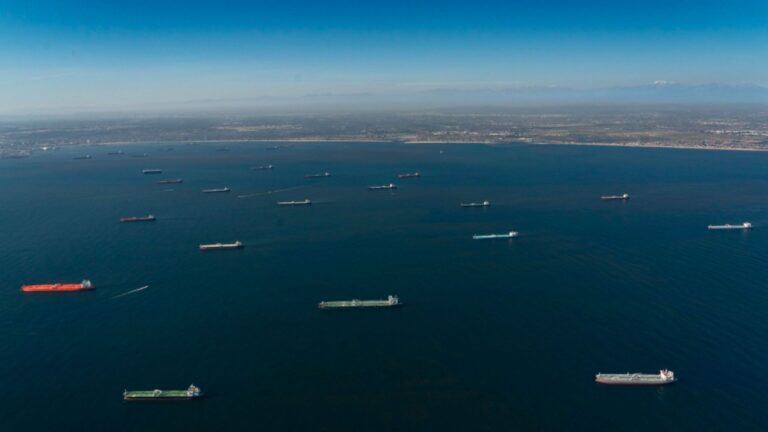
Oil Tankers sitting off the coast of Southern California on April 23, 2020. Photo by Petty Officer 3rd Class Aidan Cooney, U.S. Coast Guard
1. What’s Happening in Our Ports at San Pedro and Long Beach?
Author: Dr. James A. Fawcett, USC Sea Grant Maritime Policy Specialist/Extension Director (retired)
Media Contact: Leah Shore / lshore@usc.edu / (213)-740-1960
The COVID-19 virus is affecting our seaports with reduced deliveries and a strange sight as tankships have anchored in the outer harbor and at our extended anchorages south of Long Beach. What’s happening you ask? Here’s the story:
The two ports of Long Beach and Los Angeles (San Pedro) share 48 anchorages both inside the breakwater and south along the coastline. Anchorages are not visible from the shore, only on the nautical charts. They are identified on charts as spots where ships can drop anchor and wait for a berth to open so they can unload cargo or wait for their next assignment.
Right now, these two ports are hosting ships at anchor in both categories. There are 15 tankers waiting, duration unknown, and five more that will leave in the next few days. The unknown departures are the result of vastly reduced demand for crude oil. With cars in garages, airplanes sitting idle on the tarmac, and fewer ships at sea compounded by oil production that doesn’t have an effective on-off switch, there’s more oil than the world needs right now and no need to move it so the ships sit at anchor. Until demand is restored, some of those ships may have no place to go. There is one bulk carrier (carrying minerals or scrap steel) that is also expected to sail away soon. Of the two-vehicle carriers (bringing cars to our region from offshore manufacturers), one is leaving soon and one is not yet scheduled to leave. The cruise ships (3 of them) stay in port for a few days, set sail without passengers to cruise local waters, then return to take on provisions and exchange crew members (some leaving, some coming aboard), and then head back to sea for a few days, another COVID-19 casualty.
Container ships must be at a container terminal to discharge and load cargo so none are at anchor at this time. COVID-19 is also taking a toll on container shipments and the data shows that 74 fewer ships arrived than normal for the first four months of the year. Nevertheless, container ships will arrive this week with cargo from China, Taiwan, Korea, Mexico, Panama, Japan, and Honolulu, 23 vessels in all.
These two seaports are the busiest in the U.S. and yet the pandemic has also affected these twin mega ports. The busy season for containers will be starting in June and will extend through November so many of us will be watching to see what effect COVID-19 will have on our essential marine industry. USC Sea Grant will continue to keep you informed as we scan the waterfront.
Dr. James Fawcett has conducted extensive research on seaports and coastal management and teaches in the Environmental Studies Program and the Price School of Public Policy at the University of Southern California.
Learn more about USC Sea Grant’s work in maritime transportation and seaports.